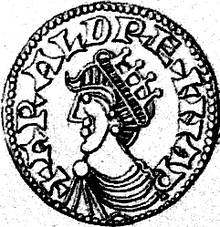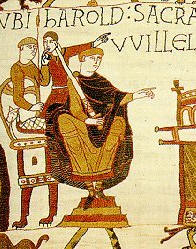Claimants to the throne in 1066
Edward the Confessor died in early 1066. As a religious man he had made a vow of celibacy, resulting in no natural heir to the throne. Several people claimed that they should be the next king of England. The claims to the throne of these men were based on blood ties; oaths; kinship and links to earlier Kings. Each claim to the throne was strong.
The claims to the throne
Edgar the Aetheling
Edgar the Aetheling was the son of King Edmund Ironside. Edmund had seen the crown seized by the Danes under Cnut. Edgar could trace his heritage as far back as King Alfred the Great. He was blood related to the Confessor. Under todays system of lineage, there would be no question at all about him being the rightful heir. However, by 1066 he had a weakened power base. His families lands and wealth had been reduced by the Danish invasions and occupation.
Harold Godwinson
Harold Godwinson was the head of the House of Wessex. Wessex was the richest and most powerful part of England. It dominated the English economy. Harold himself was well known in court. He had acted for Edward the Confessor. Harold had fought many battles, proven himself time and again and was the most trusted military commander in England.
Harold Hardrada
In Denmark, Harold the Hardrada had a claim. Edward the Confessor had usurped Harold’s father, King Magnus. Magnus had been named as the heir to the English throne by King Hardicanute. Edward had simply taken the throne before Magnus, who was quite old, could take the crown. For Harold, the crown of England was rightfully his. His father ought to have been king, his grandfather and the great Cnut, his great grandfather, had been King. England ought to be part of his Viking empire. He would take back what was rightfully his.
William of Normandy
Edward the Confessor had spent much of his youth in Normandy. The young Edward married into the Norman court. The Normans and Wessex had built up a strong relationship, they had treaties to support each other against Viking attacks and were natural trading partners. William of Normandy was a distant cousin of Edward. When Edward became king of England, he adopted many Norman ideas and many Normans began to work for his administration. William visited Edward and, it is claimed, was promised that he was the heir to Edward’s throne. Harold of Wessex, claimed the Normans, swore and oath supporting William’s claim whilst seeking refuge in Normandy.
The succession crisis of 1066: summary
The four men claiming that they are the rightful heir to the throne are all very powerful. One, Harold of Wessex, is in situ when the Confessor dies. At court when Edward passes, he is in a position to take the crown and secure key buildings. Harold Hardrada and William of Normandy are powerful: but overseas. Edgar the Aetheling has little support from nobles and is powerless, initially, to prevent any of these men from seizing his crown.
Things are more complicated as a result of ties between England, Denmark and Normandy. Non of the claimants could be entirely sure who would support which claim. The best example of this is the case of Tostig Godwinson. Tostig is the brother of Harold of Wessex. Their mother is from the Danish court.. Tostig is married to a Norman. Tostig had also, until 1065, been the Earl of Northumberland. (Note: Tostig had been ousted as Earl in 1065 and outlawed. His brother had played a role in this and it was something that Tostig resented).





